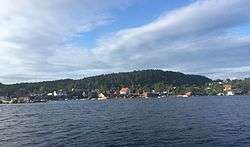Søgne
| Søgne kommune | |||
|---|---|---|---|
| Municipality | |||
|
Trysnes in Søgne | |||
| |||
 Søgne within Vest-Agder | |||
| Coordinates: 58°5′39″N 7°46′21″E / 58.09417°N 7.77250°ECoordinates: 58°5′39″N 7°46′21″E / 58.09417°N 7.77250°E | |||
| Country | Norway | ||
| County | Vest-Agder | ||
| District | Sørlandet | ||
| Administrative centre | Søgne | ||
| Government | |||
| • Mayor (2007) | Solveig Kjelland Larsen (AP) | ||
| Area | |||
| • Total | 151 km2 (58 sq mi) | ||
| • Land | 143 km2 (55 sq mi) | ||
| Area rank | 357 in Norway | ||
| Population (2004) | |||
| • Total | 10,509 | ||
| • Rank | 109 in Norway | ||
| • Density | 66/km2 (170/sq mi) | ||
| • Change (10 years) | 18.1 % | ||
| Demonym(s) | Søgnesokning[1] | ||
| Time zone | CET (UTC+1) | ||
| • Summer (DST) | CEST (UTC+2) | ||
| ISO 3166 code | NO-1018 | ||
| Official language form | Bokmål | ||
| Website |
www | ||
|
| |||
Søgne is a municipality in Vest-Agder county, Norway. Søgne was established as a municipality on 1 January 1838 (see formannskapsdistrikt). Greipstad was separated from Søgne on 1 July 1913.
It is a coastal municipality, with a long stretch of coastline to the south. To the east, it borders the municipality of Kristiansand, to the north and north-east Marnardal and Songdalen, and to the west Mandal.
As opposed to the other municipalities of Vest-Agder, Søgne has not gone through a municipal merger in recent times. On the contrary, Greipstad was separated from Søgne in 1913 (and in 1964 merged with Finsland into Songdalen. The population of Søgne was 10 509 as of 1 January 2010.
General information
Name
The municipality (originally the parish) is named after the old Søgne farm (Old Norse Sygna), since the first church was built there. The farm is named after the river Sygna (now Søgneelva) and the name of the river is derived from the verb súga which means "suck".
Coat-of-arms
The coat-of-arms is from modern times. They were granted on 24 May 1985. The arms show two typical road signs (varder), made of stones, which in historical times were used to mark the paths and tracks. Two of the largest of these signs are found in the municipality, and were already mentioned in the early 17th century. According to legend, they were already built by King Olaf II of Norway (Heilag-Olav), in the 11th century.[2]
References
- ↑ "Navn på steder og personer: Innbyggjarnamn" (in Norwegian). Språkrådet. Retrieved 2015-12-01.
- ↑ Norske Kommunevåpen (1990). "Nye kommunevåbener i Norden". Retrieved 27 September 2008.
See also
External links
 Media related to Søgne at Wikimedia Commons
Media related to Søgne at Wikimedia Commons- Municipal fact sheet from Statistics Norway
 Vest-Agder travel guide from Wikivoyage
Vest-Agder travel guide from Wikivoyage- Søgneguiden - Visitor information
- Welcome to Søgne - Tourist information
- Budstikka - Local newspaper (Norwegian)
- Søgne municipal website (Norwegian)
- Sørforumet - Forum


